Nuclear war in Europe: conceivable or “unthinkable”
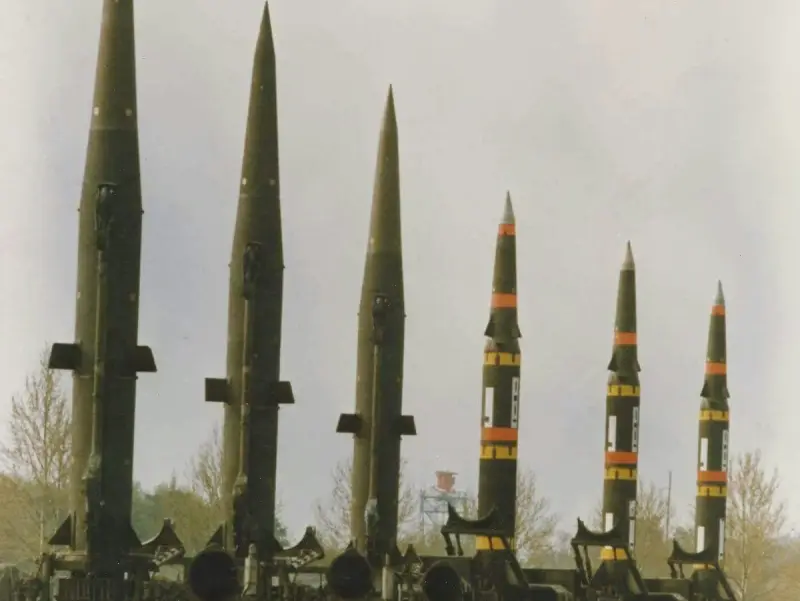
Even before the formal end of World War II, hundreds of US Air Force B-29s were stationed at permanent and temporary airfields in Europe. Since September 1945, the first B-3 (Mk-3) nuclear bombs began to arrive by sea in Europe and were intended to equip B-29 bombers. By 1956, the US Air Force had 28 aviation wings of B-47 bombers and five wings of RB-47 reconnaissance aircraft. The bombers, stationed at forward air bases in Britain, Spain, Germany and Italy, were part of the first line of America's strategic nuclear deterrent. 2000 B-47 bombers on high alert, full of fuel and loaded with nuclear weapons weapons, with crews on standby, were ready to attack the USSR in a short time.
The bomber was capable of carrying in its bomb bays 2 Mk15 nuclear bombs with a yield of 3,8 megatons each, or one B41 with a yield of 25 megatons, or one B53 with a yield of 9 megatons. The bomber had a subsonic flight speed and a range of up to 3240 km, therefore, unlike the intercontinental B-36 and B-52, it could only operate from advanced airfields in Europe. This entire armada of bombers is consolidated into three air armies - the 3rd, 16th and 17th.
In addition to bombers, the United States has deployed a large number of ground-launched medium-range cruise missiles in Europe. One of the features of the nuclear arms race carried out by the United States during the Cold War in NATO was that it was through this bloc that the United States implemented the most important measures related to the deployment of its nuclear weapons on the territory of Western European countries - member countries of the bloc , implementation of its nuclear policy and strategy. This led to an intensification of the nuclear arms race and a significant expansion of its proliferation zone. It is enough to point out, for example, that over the years of NATO’s existence, the United States has deployed over 7000 of its tactical nuclear charges and over 3000 of their carriers on the territory of a number of Western European member countries of the bloc.
From the very beginning of the negotiations on strategic arms limitation (SALT-1; 1973) back in 1972, the USSR raised the question of taking into account forward-based American nuclear weapons in Europe and Asia, which, due to their proximity to Soviet territory, were practically for us equivalent in threat to US strategic nuclear weapons. The nuclear potential of US “non-strategic” weapons, deployed on the territory of European NATO member states, created a direct threat to the Soviet Union and its allies.
By 1962, the US Air Force had more than 1300 intercontinental and medium-range bombers in service, capable of delivering about 3000 nuclear warheads to the territory of the USSR. In addition, the United States was armed with 183 Atlas and Titan ICBMs and 144 Polaris missiles on nine SSBNs of the George Washington and Athene Allen class. The Soviet Union had the opportunity to deliver about 600 warheads to the United States, mainly with the help of strategic aviation, and 6 R-7 (SS-6) missile launchers and 220 R-16 (SS-7) ICBM launchers, which had a low degree of combat readiness and high cost creation of launch complexes, which did not allow large-scale deployment of these systems. The Soviet Union needed to neutralize the nuclear threat hanging over the socialist countries, and here ballistic missiles were ideally suited, as they say, “cheap and cheerful.”
In the 1950s, we had two design bureaus working on medium-range ballistic missiles: OKB-1 by Sergei Pavlovich Korolev and OKB-586 by Mikhail Kuzmich Yangel. The Korolev R-5M (SS-3 Shyster) missile was the first to enter service. In 1959 and 1960, MRBMs developed by OKB-586 M.K. Yangel - R-12 and R-14 - entered service. By the beginning of the Caribbean crisis, 48 R-5M (SS-3), 564 R-12 (SS-4) and 70 R-14 (SS-5) launchers were deployed in the western part of the USSR. If the Caribbean crisis had developed according to a negative scenario, then this entire armada of Soviet missiles 15 minutes after launch would have fallen on NATO’s military infrastructure, primarily the air defense systems - the Nike Hercules, Hawk and Bloodhound air defense systems. And also to airfields, bases of fighter and bomber aircraft. But this is only the first part of the Marlezon Ballet; after a two-hour intermission, the hour of “doomsday” would come, or, better suited, the “hour of the apocalypse” - 1500 Soviet Tu-16 and Tu-22 bombers would freely enter the airspace of Western Europe. A process would begin that has now received a very apt and precise definition: “Glassing of Europe.” In order to arrange a “nuclear apocalypse” in Europe, both sides – the USA and the USSR – had enough strength and means. According to the authoritative American expert Walmtetter, as of October 1962, the United States had 26 nuclear charges, the USSR - 700. The power of these charges, both individually and the total arsenal, is orders of magnitude higher than that of modern ones.
For example: a hypothetical attack - a Tu-22A bomber strikes the capital of Great Britain, London, with a 25-megaton bomb. London is 50 miles across, that is, the diameter of the city including its suburbs is 80 km. The population of Greater London in 2023 was just under 10 million. I don’t think it was much smaller 50 years ago. The explosion took place over the geometric center of London at an altitude of 2500 meters. Excess pressure in the shock wave front within a radius of 32 km from the epicenter of the explosion would be 50-70 kPa (0,51–0.71 kg/sq. cm) - this is a zone of complete destruction for residential and industrial buildings made of concrete and reinforced concrete buildings with lightweight metal frame and frameless design. The city, along with its outskirts, will be completely destroyed. The entire population (100%) in the zone of complete destruction will die instantly, and beyond the 32-kilometer radius the population will still die either within a few hours from third-degree burns or within two weeks from radiation sickness. A single Tu-22A bomb attack would have killed 10 million Londoners. The same fate would await all large and small cities in Western and Eastern Europe.
In the fall of 1962, the USSR had 1500 medium-range strategic bombers (2500-3000 km) Tu-16, 150 intercontinental (up to 7000 km) Tu-95 bombers and 40 M-4 intercontinental bombers. For these bombers, at air bases in the western part of the USSR, there were about 300 SAB-9000 aerial bombs (product 201 and 202) with a capacity of 20 and 25 Mt, respectively, in special storage facilities. But the USSR had only a few intercontinental-range missile weapons in October 1962 - 30 R-16 ICBM launchers (SS-7 Saddler), 6 R-7 ICBM launchers (SS-6 Sapwood) and 72 R-13 SLBM launchers (SS -N-4 Sark) with a flight range of 600 km.
Things weren't much better for the United States. The main striking force is the B-52 strategic intercontinental bombers, and in the fall of 1962 there were 744 of them in the US Air Force, brand new, just out of production. However, the Soviet bombers were also all brand new. American strategic bombers were armed with their own superbomb - the B-41. About 500 B-41 units were manufactured between September 1960 and June 1962. In total, the USSR had 3080 thermonuclear aerial bombs in its arsenals, the United States had 26. And the power of thermonuclear warheads of ICBMs and SLBMs of that time was an order of magnitude inferior to aerial bombs, maximum 700-3 Mt. After 6 years, the structure of the nuclear strategic and non-strategic forces of the USSR changed quantitatively - the majority were missile warheads - tactical, operational-tactical and strategic, aerial bombs accounted for less than one percent of the total. The most powerful Soviet “physical packages” AA 20 and AA 201 in the period from 202 to 1966 migrated from heavy aerial bombs to the warheads of heavy R-1969 (SS-36) missiles. Of the 9 R-288 ICBMs deployed in silos, 36% of the missiles were equipped with these very “physical packages”, and about 80% were equipped with lightweight “physical packages” AA 20 of lower power - 101 Mt. According to American expert Robert Johnston, the Arzamas 8,3-megaton “physical package” AA 8,3 in the 101F8 warhead housing (“light” warhead) for Yangel’s R-674 missiles weighs 36 kg. When naked, YAZU AA 3950 weighs about 101 kg. Subsequently, it was installed on monoblock versions of heavy missiles of the 3000th generation R-4M, R-36M UTTH and R-36M36.
Two divisions of “heavy” ICBMs R-36M UTTH were deployed in Kazakhstan - 54 silo launchers of R-36M UTTH missiles (6 regiments) were deployed as part of the 57th missile division in Zhangiz-Tobe (Solnechny) Semipalatinsk region, another 50 missiles (5 regiments ) R-36M UTTH are deployed in the 38th Missile Division in Derzhavinsk, Turgai Region. The dismantling of 104 launchers located in Kazakhstan was completed in September 1996. 30 missiles out of 104 in the 38th and 57th RDs were deployed in a monoblock version with 101 “physical packages”. A range of 18 km made it possible to do this.
In the 13th missile division (Dombarovsky, Yasnaya), from December 1973, R-30M missiles were installed in 36 silos, subsequently R-36M UTTH and R-36M2, equipped with monoblock warheads 15B86 (heavy warhead) with “physical packages” AA201 and AA202 with a capacity (according to Western sources) of 20 and 24 Mt, respectively. The weight of these devices is just over 5000 kg.
The outer diameter of the midsection of the “physical packages” is 1500 mm and 1770 mm, respectively. That is, both nuclear weapons are suitable in terms of their weight and dimensions as combat equipment for the 2M39 torpedo. They would also be perfect as combat equipment for monoblock versions of the latest “heavy” Sarmat ICBM. I really hope that these 60 “physical packages” are not destroyed, but are gently and carefully stored in the warehouses of the 12th GUMO.
40 years ago, at the height of the Cold War, the greatest concern for the Soviet side was the American FB-111 bombers stationed at the Royal Air Force bases Greenham Comon and Molesworth in the UK, of which 65 units were deployed there, as well as 240 carrier-based US Navy A-6 and A-7 attack aircraft stationed on five aircraft carriers of the 2nd and 6th fleet USA, whose range exceeded 1000 km. They covered most targets in the European part of the USSR. With the advent of the Tu-1974M Backfire bombers in the Soviet Air Force and ADD in 22, questions arose among the Americans.
The non-strategic nuclear forces of the USSR included, first of all, surface-to-surface or surface-to-surface missiles of various types with a launch range from 70 km to 5500 km, which were in service with the Strategic Missile Forces and the Ground Forces, nuclear artillery of the Ground Forces, nuclear aviation, assigned to the Air Force and Navy, as well as non-strategic sea-launched ballistic and cruise missiles, nuclear torpedoes, anti-submarine missiles and nuclear depth charges assigned to the Navy. American estimates show that by the mid-1980s there were 15 nuclear warheads in this category of weapons, representing 400% of the entire Soviet nuclear arsenal. Surface-to-surface missile warheads accounted for 47% of this amount. Warheads delivered by tactical aviation, excluding naval aviation - 31%, nuclear artillery shells - 33%, warheads assigned to the Navy - 13%.
Nuclear weapons assigned to the USSR Ground Forces are nuclear shells 3BV2 (203 mm), 3BV3 (152 mm), 3BV4 (240 mm) and short-range tactical missiles: 9K79 “Tochka” (SS-21 Scarab A), 9K52 “Luna” -M" (FROG-7), operational-tactical: 9K714 "Oka" (SS-23 Spider), 9K76 Temp-S (SS-12M/SS-22 Scaleboard), 9K72 "Elbrus" (SS-1С Scud B) .
In Europe, the United States deployed the MGM-1950A Mace medium-range missile defense system in the second half of the 13s. The MGM-13A Mace missiles have been deployed in the military since 1959; in addition to them, the MGM-13B modification with a range increased to 2400 km entered service. The missiles were equipped with a high-power thermonuclear warhead W28, with a power of 1,1 Mt. The missiles were deployed in the 38th Tactical Missile Wing in Germany. A total of 200 Mace launchers were deployed in Europe. To these “non-strategic” US forces in Europe it was necessary to add the strike capabilities of the carrier-based aircraft of the 2nd (North Atlantic) and 6th Fleets (Mediterranean Sea) of the US Navy. And this is 240 A-6, A-7 attack aircraft and F-4 fighter-bombers, capable of delivering up to 480 B-43, B-57 nuclear bombs in one flight. The B43 has been developed since 1956 by the Los Alamos National Laboratory, and mass production began in 1959. Entered service in April 1961. A total of 2000 units were produced, with production ending in 1965. Ammunition power from 70 kt to 1 Mt. A classic aerial bomb for use against ground targets. Removed from service between 1989 and 1991.
The B57 tactical aerial bomb, universal, was intended for strikes against ground targets, sea (ship formations) and as a depth bomb to fight submarines. Produced from January 1963 to May 1967.
A total of 3100 units were produced during this period. The aircraft bomb, 3 meters long, with a diameter of 375 mm, belonged to the 500-pound class (227 kg) and had a power depending on the modification: Mod 0 - 5 kt, Mod 1 and Mod 2 - 10 kt, Mod 3 and Mod 4 - 15 kt, and Mod 5 – 20 kt. Some of the B43 and B57 bombs were stored on board US aircraft carriers of the 2nd and 6th fleets and at US air bases in Europe, from 100 to 108 units per aircraft carrier. Another 540 nuclear bombs B43 and B57 were on board aircraft carriers of the US 7th Fleet, the rest were at Air Force and Navy bases in the United States.
A total of 2330 "non-strategic" American nuclear weapons deployed in Europe as of 1989 for tactical missiles and artillery shells. Located at US bases in NATO countries - 850 warheads of W-70 tactical missiles "Lance", 180 warheads of W50 tactical missiles "Pershing-1A" and 1300 artillery shells of 155 mm caliber W-48/M451, W-82/M- 785 and 203 mm W-33/M-422, W-79/M-753 shells.
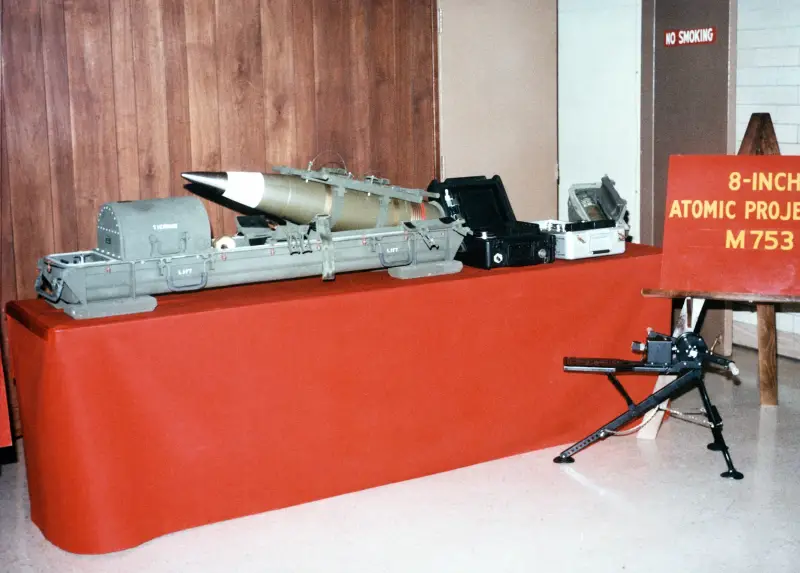
American 8-inch (203 mm) nuclear artillery shell W-79/M-753
According to American estimates, in the mid-1980s, “non-strategic” aircraft of 14 different types, subordinate to the USSR Air Force and Navy, were capable of carrying nuclear weapons. According to American experts, of the 102 warehouses of the 12th GUMO, 75% were geographically located in the European part of the USSR, and in the mid-1980s they stored approximately 6800 nuclear charges, including 4900 nuclear bombs, 1500 nuclear warheads for the Kyrgyz Republic "Air-to-surface" and 400 universal naval aviation bombs.
The number of Tu-22M2/M3 deployed as of April 1988 was 321 bombers. Almost equally divided between the Air Force (ADD) - 178 aircraft, and Navy aviation - 143 aircraft. The aircraft was armed with one or three X-22 air-to-surface missiles (AS-4 a/b/c), the missile had a launch range in various modifications from 280 to 560 km. In addition to the conventional warhead, it could also be equipped with a nuclear TK 55. Experts from IISS, Military Balance 1987-1988 claim that its power is 1 Mt, but experts from Collins and Victory, US/Soviet Military Balance 1988 are closer to the truth and indicate a power of 500 kt . It should be noted that 500-kiloton “physical packages” have become the most common in the Soviet strategic and “non-strategic” arsenal since the second half of the 1970s. In 1973, VNIIEF created its ingenious brainchild - a series of medium-class charges with a power of 500-550 kt - A-104/134. We can say that this is the most popular thermonuclear charge in the armed forces of the USSR. It was installed on almost all carriers: from tactical, operational-tactical and cruise anti-ship missiles to strategic ICBMs and SLBMs. From 1974 to 1985, according to various estimates, from 8000 to 10 chargers were produced. In the Strategic Missile Forces in the second half of the 000s and the first half of the 1970s, all 1980th generation missiles equipped with MIRVs received A-4 charges in the form of 134F15 warheads, 174 warheads per R-10M UTTH missile (SS-36 Mod 18), 4 per UR-6N UTTH missile (SS-100 Mod 19) and 2 per UR-4 MR missile (SS-100Mod 17). But not only ICBMs with MIRVs, but also monoblock missiles received A-2 charges, and old 134rd generation missiles - RT-3P (SS-2 Mod 13), and the newest (mid-2s) 1980th generation – RT-5PM “Topol” (SS-2). In total, the Strategic Missile Forces received about 25 A-7000 devices. At the end of the 134s, all A-1980 charges underwent modernization, during which the power of the nuclear charge was increased to 134 kt, and work was also carried out to extend the service life. The same “physical packages” (A-750) were installed on the operational-tactical ballistic missiles 104K9 Temp-S (SS-76M/SS-12 Scaleboard), 22K9 “Elbrus” (SS-72C Scud B).
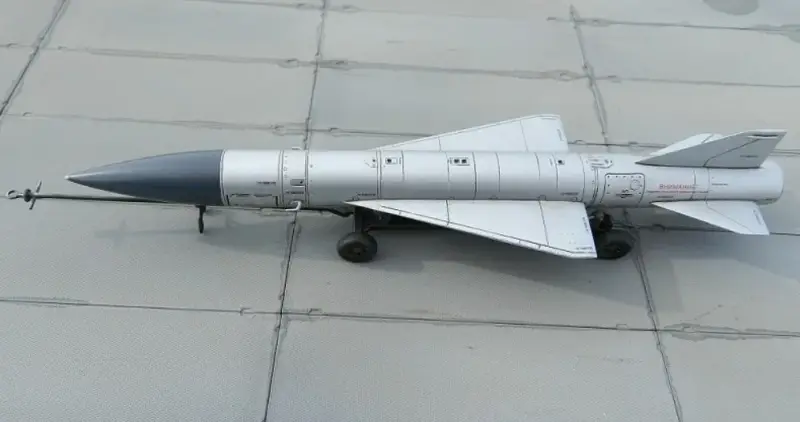
Cruise missile X-22
The most common American nuclear warheads in Europe until the end of the 1970s were the W31, which were used as the main combat equipment for the two types of the most popular American missiles - the MIM-14A Nike Hercules missile defense system and the MGR-1A Honest John TBR. In 1979, the Americans removed 1400 W31 warheads from Europe due to the massive withdrawal from the arsenal of NATO countries of the main carriers - the Nike Hercules air defense system and their MIM-14A missile defense system and the MGR-1A Honest TBR. The W31 “physical package” has been produced since 1959, the latest versions were withdrawn from service in 1989. All versions had approximately the same weight and size characteristics - 28-30 inches (710-760 mm) in diameter, 39-39,5 inches (990-1000 mm) in length and weight 900-945 pounds (408-429 kg). The "physical package" had three power options - 2, 20 and 40 kilotons. A total of 1650 W31 warheads were produced for the Honest John TBR and 2550 warheads for the Nike Hercules SAM.
The balance of power between NATO and the USSR in medium-range (from 1000 to 5500 km), tactical (up to 100 km) and operational-tactical (from 100 to 1000 km) nuclear weapons existed for more than 20 years (1962-1983).
Numerous official statements by the leaders of the United States and other NATO countries, made in the 1978-1980s in various publications, stated that due to the “disturbance in the balance of power” as a result of the deployment of the SS-20 missile systems (RSD-10) by the Soviet Union Pioneer"), NATO countries must go for “rearmament”. On the eve of the December session (1979) of the NATO Council, the West even deliberately inflated data on Soviet medium-range missiles. The White Paper of the German Ministry of Defense for 1979, for example, stated that the Soviet Union as of 1979 had 600 medium-range missiles, of which 500 SS-4 (R-12) and 100 SS-20. The London Institute for Strategic Studies in its publication “Military Balance 1979-1980” went even further. The Soviet Union, the brochure noted, has 500 SS-4, 90 SS-5 (R-14) and 120 SS-20 missiles. Both publications indicated that in subsequent years the rate of increase in SS-20 missiles would be approximately 50 units (PU) per year; in 1980, their number should therefore have been 150-170 units. After the NATO Council adopted a decision on “rearmament” in December 1979, the propaganda need to so clearly overestimate the number of Soviet medium-range missiles became less relevant. In the annual report of US Secretary of Defense Caspar Weinberger on the budget for the 1981 fiscal year, it was noted that the total number of Soviet SS-20 missiles was not 150-170 units, as follows from data published in Bonn and London, but only 60 units, that is, half or even a third of the figures that appeared in the West on the eve of the December (1979) session of the NATO Council. As for the rate of build-up of SS-20 missiles, in accordance with the report of the US Secretary of Defense, they were now estimated to be approximately one and a half times lower - 30-40 missiles per year. At the same time, the report indicated that of the total number of these missiles, approximately two-thirds would be deployed in the European part, in other words, 20-27 missiles.
In September 1983, Chief of the General Staff of the USSR Armed Forces N.V. Ogarkov for the first time stories at a press conference broadcast on the central channels of Soviet television, he announced the official figures of the Soviet counterforce medium-range nuclear potential and the figures of the opposing NATO forces. On September 1, 1983, the Soviet Union had 938 carriers of medium-range nuclear weapons - 473 MRBMs and 465 aircraft. NATO countries had 857 carriers at their disposal - 162 Anglo-French SLBMs and MRBMs and 695 aircraft. There is approximate equality in medium-range nuclear weapons. Although the difference in structure was obvious: the USSR had more missiles, and NATO had more aircraft, as well as a one-and-a-half superiority in nuclear warheads. NATO medium-range weapons could carry 3056 charges in one launch (flight), and the corresponding USSR weapons could carry 2153. However, the leaders of the USA and NATO groundlessly talked not only about “quantitative superiority”, but also about “qualitative superiority”. It was expressed, they say, in the fact that the USSR has ground-based mobile launchers of medium-range SS-20 missiles, while the United States does not have similar missiles. Indeed, the US did not have such facilities in Europe until November 1983. However, this did not at all give the United States the right to demand the presence of its own – American – missile counterweight on this continent. The United States already had such a counterweight at that time in the form of forward-based nuclear weapons, and these were 650 aircraft. These planes alone were capable, according to Western estimates, of destroying up to 20 percent of the population and industrial power of the USSR. If we talk about a counterweight in the form of missiles, then Great Britain and France had them then and have them now. In 1983, they had a total of 162 missiles: 64 British Polaris A-3 SLBMs, 80 French M-20 SLBMs and 18 S-3 MRBMs. Of course, this is less than the USSR had medium-range missiles. But NATO had many more bombers and fighter-bombers. The advantages of one side were compensated by the advantages of the other, which expresses the essence of the balance of power. It was important, according to NATO military experts, that the Soviet SS-20 missiles were equipped with MIRVs with three warheads, while the Anglo-French ones were monoblock. Yes, but already in 1985, the new SSBN of France, the Enflexible, came into operation with new M-4 missiles equipped with MIRV IN with six warheads, and in the UK there was an active re-equipment of the Polaris A-3T SLBM with a dispersive MIRV with three W-58/Mk-2 warheads on the Shevaline MIRV with two warheads of higher power up to 225 kt, with the ability to target individual targets (up to 64 km).
IRBM RSD-10 “Pioneer” (SS-20 Saber) was developed by the Moscow Institute of Thermal Engineering (MIT), chief designer – A.D. Nadiradze, using the experience of creation and on the basis of the PGRK “Temp-2S” / SS-X-16. The 15Zh45 missile was created on the basis of the 1st and 2nd stages of the Temp-2S solid-fuel ICBM. The theme of the R&D project for the creation of the PGRK was called 15K645 “Pioneer”. Work on the complex began in 1971. The complex was adopted for service by Resolution of the USSR Council of Ministers No. 177-67 of March 11, 1976. On August 30, 1976, the first missile regiment went on combat duty as part of the Gomel Missile Division (396th Missile Regiment, 33rd Guards Missile Division, Belarus, Petrikov missile base).
The missile launch range, according to the CIA, based on intelligence data, satellite photographs and interception of telemetry from test launches, which was prohibited from being encrypted under the SALT I treaty precisely in order to facilitate the receipt of information by both sides (the Americans were also obliged not to encrypt telemetry information from test launches missiles and mask missile launch positions and places where warheads fall at training grounds). So... Based on these data, the CIA determined the missile's range to be 1 miles (2750 km), while, according to US military intelligence, the missile's launch range was 4400 miles (3100 km).
The 15F453 warhead breeding stage includes 15F452 warheads, a 15L747 sealed instrument compartment, a 15N191 static current converter, a 15Ya117 rocket gyroblock standby thermal control system, 4 x 15D69P low-thrust solid propellant rocket engines. The upgraded 15Zh53 rocket had a larger instrument compartment in diameter to accommodate a more advanced control system. The total throw weight is 1740 kg for 15Zh45 missiles and 1600 kg for the improved 15Zh53.
Full routine maintenance of the 15F452 MRSD 15Zh53 combat unit was carried out once every 1 years.
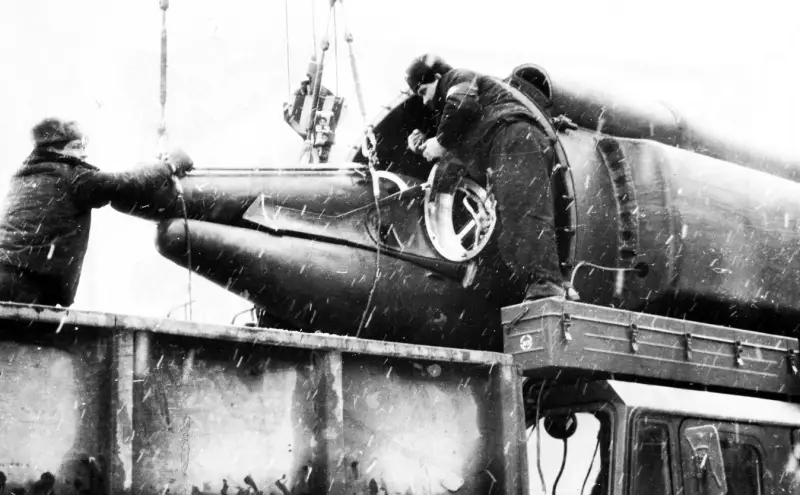
The 15F452 combat unit had the shape of a cone with a base diameter of about 64 cm and a height of 1,6 meters. Each warhead weighed 290 kg. The 15F452 combat unit was intended to equip the MIRV IN BRSD 15Zh45 “Pioneer” and 15Zh53 “Pioneer-UTTH”. YAZU AA-74 was developed by VNIITF. The charge had a power, according to Collins and Victory, US / Soviet Military Balance 1988 - 150 kT, and this figure has been fixed in the public consciousness for almost 40 years, although it has nothing in common with reality. The real power of the AA-74 nuclear weapon is 400 kt (this is the figure indicated on the 15F452 warhead tablet in the Nuclear Weapons Museum in Arzamas). For the first time, Soviet nuclear physicists from VNIIEF and VNIITF surpassed their opponents from Los Alamos and Livermore in the specific power of nuclear charges precisely on the AA-74/15F452 product of the RSD-10 “Pioneer” complex. Three years after the Pioneer, the Americans are adopting new combat equipment for their Minuteman-3 ICBMs. The missile received an improved NS-20A inertial navigation system, with improved accuracy (CEP decreased from 270 meters with the previous NS-20 system to 220 meters). The warhead of the previous RS-14 breeding unit received new W-78/Mk-12A warheads with increased power to 350 kt, the weight of each warhead being 335 kg. The total throwable weight of the warhead with the breeding unit has increased compared to the previous Mk-12 model from 1150 kg to 1200 kg. The small, I would even say microscopic, weight of the RS-14 DU breeding unit and the fuel reserve, less than 17% of the total thrown weight, led to the low capabilities of the unit for breeding warheads. The maximum separation distance between the aiming points of the first and third warhead does not exceed 50 miles (80 km). And the range fell from 13 km to 000 km, and the throwing weight increased by only 11 kg.
“Pioneers”, depending on the modification of the rocket, had a CEP of 150-500 meters. Western experts are still convinced to this day that there was a test modification of the complex - 15P157 Pioneer-3, with a new 15Zh57 missile (SS-20 SABER mod.3 / SS-X-28 SABER) with a launch range increased to 7500 km. In fact, this is not so; for a new modification they took the version of the 15Zh53 missile (Pioneer - UTTH) with reduced combat equipment (from three warheads to one). Due to a significant reduction in the throwable weight of the missile in this configuration - from 1600 kg to 1020 kg (60%) - the launch range increased from 5500 km to 7500 km.
On December 12, 1979, the NATO commander decided to deploy 572 new nuclear missiles in Western Europe. The US Army planned to replace the Pershing 1a of the 56th Artillery Brigade deployed to West Germany with the Pershing II in 1983, while the German Air Force would retain its Pershing 1a. A total of 108 Pershing II missile launchers and 464 BGM-109G Gryphon land-based cruise missile launchers. Of the cruise missiles, 160 were supposed to be placed in England, 96 in West Germany, 112 in Italy (Sicily), 48 in the Netherlands, 48 in Belgium. All 108 Pershing II missiles were to be stationed in West Germany to replace the aging Pershing 1a missiles. The German Air Force also planned to replace its 72 Pershing 1a missiles with new short-range Pershing 1b missiles, but the Americans refused without explanation.
An important aspect of NATO's decision was its willingness to bargain with the Soviet Union for the reduction or complete elimination of these missiles against similar reductions or elimination of the Soviet SS-20 missiles. NATO's condition for not proceeding with its missile deployment plans would be the Soviet Union's willingness to stop the deployment of mobile SS-20 missiles that could be aimed at Western Europe, and to remove the SS-20s already deployed. NATO estimates that in early 1986 the Soviet Union deployed 279 mobile SS-20 launchers with a total of 837 nuclear warheads based in the western regions of the USSR.

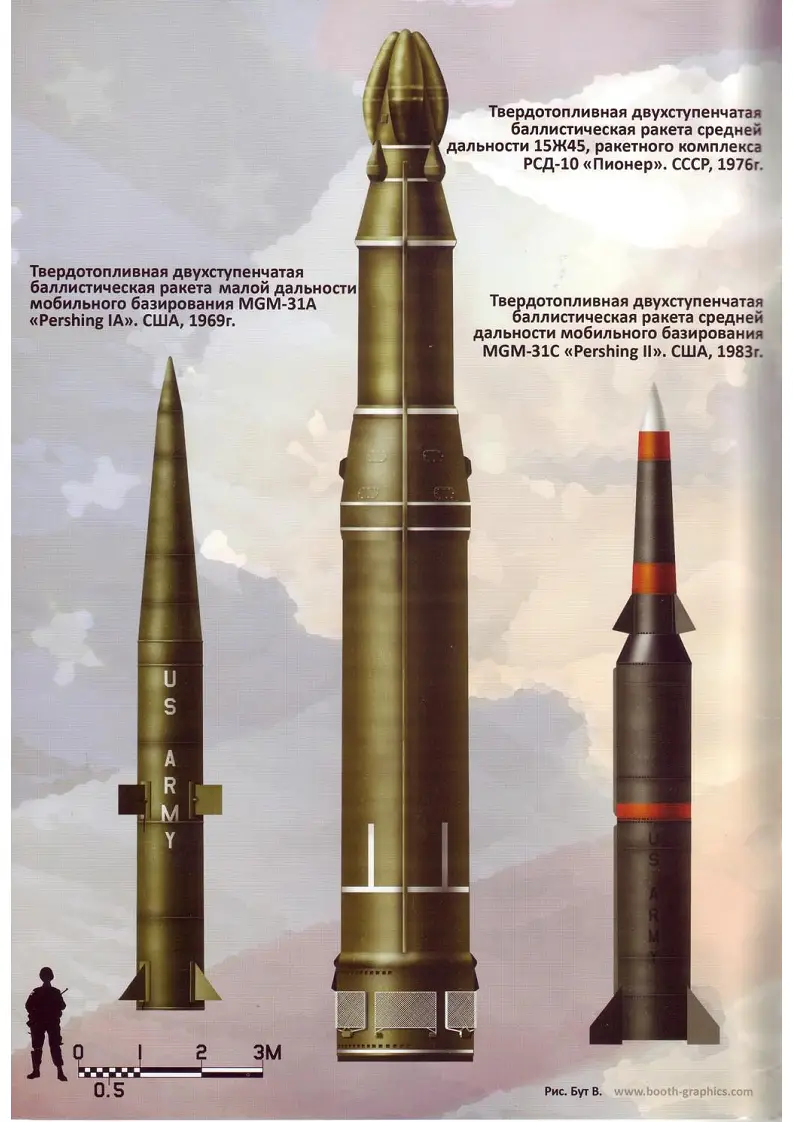
The first Pershing II missiles were deployed in West Germany at the end of November 1983, and the deployment of all 108 PU missiles and 120 missiles, and the same number of W-85 warheads for them, was completed at the end of 1985. Initial Operating Status (IOS) was achieved on 15 December 1983, when the 1st Battery, 1st Battalion, 41st Field Artillery Regiment entered operational status with the command of the 56th Artillery Brigade at Mutlangen. By 1986, all three missile battalions were deployed with 108 Pershing II missiles stationed in West Germany at Neu-Ulm (3rd Battalion, 84th Field Artillery Regiment), Mutlangen and Neckarsulm (1st Battalion, 81st Field Artillery Regiment) ). The W85 thermonuclear warhead was developed by Los Alamos National Laboratory specifically to equip the Pershing II MRBM. This is a variable power RAM with a choice of power of 0,3, 5, 10 or 80 kilotons of TNT equivalent. The Pershing Ia missile was equipped with a W50 warhead with a yield of 400 kilotons of TNT. By the early 1970s, it became clear that its yield was excessive for an operational-tactical missile—at that time, 400 kilotons was more than many American strategic warheads. The Pershing II MRBM had a high-precision maneuvering (guided) warhead (MARV), equipped with a RADAG radar seeker system, which allowed the missile to use a lower-power W85 warhead. This warhead was designed based on the W61 Mod 3 nuclear warhead. The total weight of the Pershing II warhead section was 268 kg, including the warhead housing. In 1987, a joint Army and Department of Energy study concluded that it was technically and financially feasible to replace the W50 warhead carried by the Pershing 1a with the W85 warhead developed for the Pershing II. However, with the signing of the Intermediate-Range Nuclear Forces Treaty, development of the conversion was stopped. After the Pershing missiles were scrapped, all produced W85 warheads were modified into B61 Mod 10 bombs. A total of 215 W85 warheads were produced.
The Soviet nuclear arsenal of “non-strategic” weapons, like the American one, in the 1950s-1970s. consisted largely of free-fall nuclear bombs.
244N, 8U69 – 5 kt nuclear bomb (MiG-21PFM, MiG-21S, Su-7), 407N – 5 kt nuclear bomb (IL-28), 8U46 – 5 kt nuclear bomb (Su-7), 8U47 – nuclear bomb 5 kt (Su-7), 8U49, 6U57, 8U63 - nuclear bomb (Su-17), 9U64, RN-25, RN-28 (especially for the Yak-28), RN-29. And megaton-class aerial bombs for strategic aviation (long-range): RN-30, RN-32, universal RN-34 and RN-35 (especially for Tu-142), RN-36, RN-36-01, RN-36V, RN -36L.
Tactical aerial bombs, “two-stage” with an energy release power of 30 kt - RN-40, RN-40-S02, RN-40-5, RN-40-6 for Il-38, MiG-23, MiG-29, Su-17 aircraft, Tu-142, Yak-28. RN-41, RN-42, RN-43.
N32 (or RN-32) is a strategic air bomb. Developer – FSUE “RFNC-VNIITF” (Snezhinsk, Chelyabinsk region). Strategic air bomb N32 (or RN-32) megaton power class. Application - from long-range aircraft - Tu-16, Tu-22A, Tu-22M2/M3, front-line fighter-bombers of the Air Force Su-24M. Chief designers - L. F. Klopov, O. N. Tikhane. Development period: 1970-1980. In service - 1980-1991.
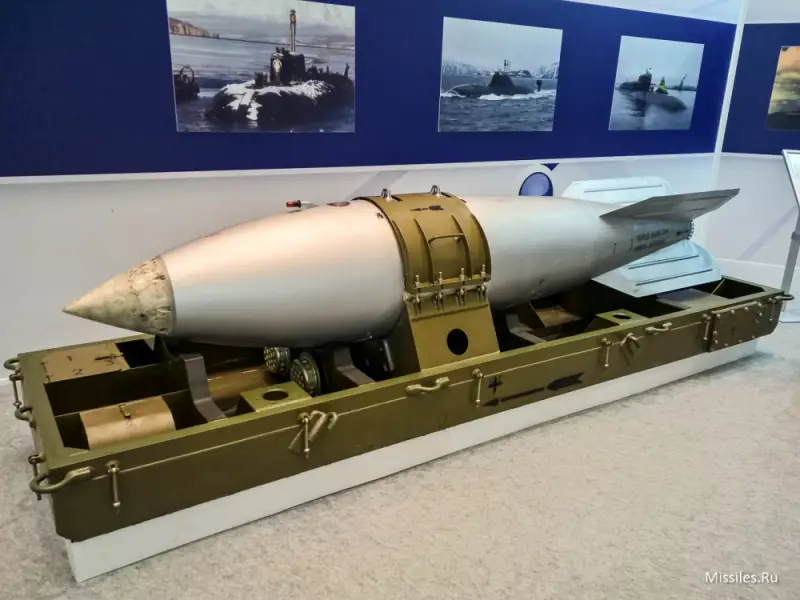
Air bomb RN-40
Entered service in 1971. Developed at the Russian Federal Nuclear Center - VNIITF (Snezhinsk). Serial production – Instrument-Making Plant (Trekhgorny). The weight of the aerial bomb is 430 kg. Information from a sign at the nuclear weapons exhibition in the Chelyabinsk Museum of Local Lore, December 2015.
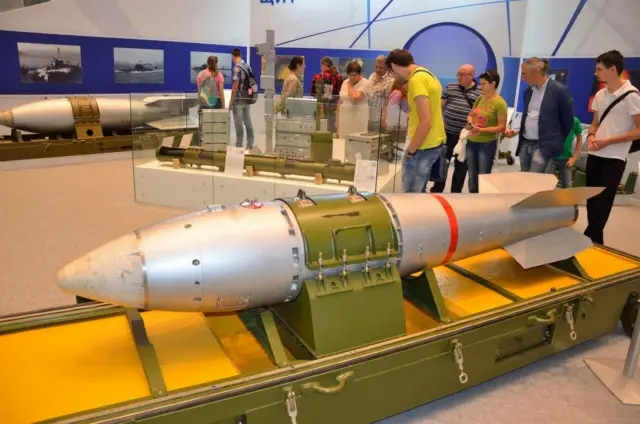
Nuclear aerial bomb RN-28. Exhibition “70 years of the nuclear industry. Chain reaction of success." Central Manege
Developer – Russian Federal Nuclear Center – All-Union Scientific Research Institute of Experimental Physics (RFNC-VNIITF), Snezhinsk, Chelyabinsk region. Chief designer – Klopov Leonid Fedorovich.
Tactical nuclear weapons were developed in the mid-1960s. The product was put into production in 1969. The aerial bomb was withdrawn from service in 1990. All reserves were disposed of during 1991-1993. Manufacturer: Instrument-Making Plant, Trekhgorny, Chelyabinsk region. The chief designer of the plant in 1969 was Pyotr Nikiforovich Mesnyankin.
The bomb body has a streamlined aerodynamic shape with a low drag coefficient. Stamped "loose feather" type tail with four stabilizers. The front part is made of radio-transparent material to accommodate the radio altimeter of the detonation system. The tail cone contains a brake parachute container. In accordance with the technical specifications, the aerial bomb could be suspended on front-line aircraft of the MiG-21, MiG-23, MiG-27, Su-7B, Su-17M 1/2/3/4 types. Bombing is allowed from a height of 500 to 3000 m, both in horizontal flight and from a nose-up.
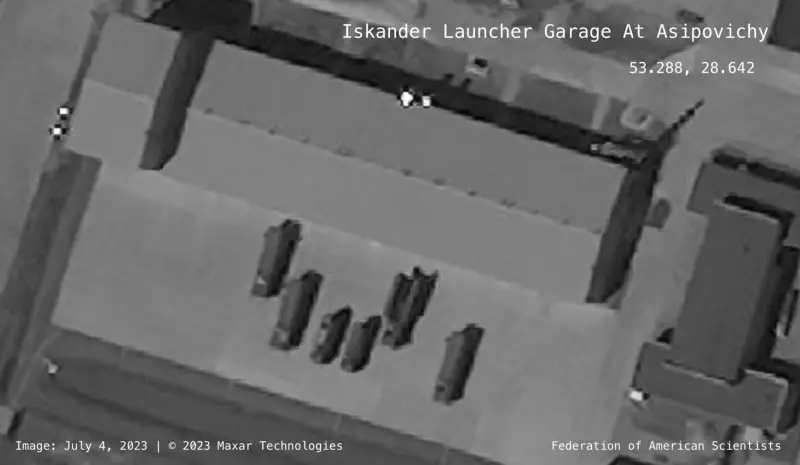
Belarusian Iskanders
After the elimination of the 1987K9 Temp-S (SS-76M/SS-12 Scaleboard) and RSD-22 Pioneer (SS-10 Saber) missiles under the INF Treaty (20), we have huge “holes” in our operational-tactical depth capabilities ( 500-1000 km) and in medium-range strike weapons (1000-5500 km). Aviation cannot carry out these tasks, which were carried out by OTR and IRBM - this was obvious even then, and certainly obvious today. Neither the Su-34 nor the Tu-22M3 are capable of overcoming the air defenses of NATO countries.
Today, NATO's nuclear arsenal consists of:
The British component is 64 Trident-2 SLBMs on four SSBNs, normally carrying 160 W-76/Mk4 warheads, with a maximum of 225.
The French component is 64 SLBMs M-51.1 and M-51.2 on four SSBNs, carrying a total of 384 TN-75 and TNO warheads. Plus ASMP-A air-to-surface missiles with TN-81 nuclear warheads (40 units).
In total, the total potential of medium-range weapons of France and Great Britain is 649 nuclear warheads. If we add the American arsenal deployed in Europe to the combined Anglo-French arsenal, we get a total of 829 nuclear warheads. Almost all of them have medium-range carriers of 1000 km and above.
The United States currently has a “non-strategic” nuclear arsenal, deployed in Europe and partly in the warehouses of the US Department of Defense in the United States, according to experts Joshua Handler and Hans Christensen from FAS, formally small - only 230 B61-3 and B61-4 bombs with a power of 170 and 45 kt respectively. The bombs are intended for tactical aircraft F-15E, F-16 DCA, F-35A. Of this number, 180 bombs are stored at NATO tactical aviation bases in Europe: 20 at Kleine Brogel (Belgium), 20 at Buchel (Germany), 70 at Aviano, Ghedi Torre (Italy), 20 at Volkel (Netherlands), 50 at Incirlik (Turkey). Another 50 are located in the United States.
What do we have today with the “counterforce nuclear potential” in the European part of Russia?
Of the medium-range weapons - 30 Tu-22M3 bombers (40 years ago there were 330 units) + 9 or 10 MiG-31K fighters armed with the Kinzhal ASBM, and that’s all, there is nothing else from the medium-range weapons.
Operational-tactical assets (up to 1000 km) - one brigade - 52nd Guards Missile Brest-Warsaw, Order of Lenin, Red Banner, Order of Kutuzov brigade (Chernyakhovsk, Kaliningrad region). The brigade has been armed with the Iskander operational-tactical missile system since February 5, 2018, 12 SPU 9P78-1 with 24 missiles.
In Belarus, the construction of new boxes for mobile launchers 9P78-1 and TZM 9T250 of the Iskander complex, received from Russia, has been completed.
The new facility (photo published in the American journal Bulletin of the Atomic Scientists - https://thebulletin.org/) was added to the existing base at Osipovichi in central Belarus, which is home to the 465th Missile Brigade. Satellite imagery shows construction began in October 2022 and completed in April 2023. A Maxar satellite image taken on July 4, 2023 shows four 13-meter 9P78-1 Iskander launchers and two smaller 9T250 TZMs near the bays. The new facility is located just seven kilometers from the test site where Iskander launchers were first geolocated, and 12 kilometers from the weapons depot of the 12th GUMO, which, according to experts from the FAS, may be modernizing a temporary storage facility for nuclear warheads.
The 465th Missile Brigade (465 rbr) of the Ground Forces of the Republic of Belarus, instead of the OTR-21 Tochka-U complexes, received the modern Russian 2023K9 Iskander complex in 720. The 9M723 ballistic missile of the Iskander complex can be equipped with three types of nuclear warheads: 9N39 with an AA-60 nuclear warhead with a variable power of 10-100 kt, 9N64 with an AA-86 nuclear warhead with a variable power of 5-50 kt, 9N64 with an AA-92 nuclear warhead with a variable power of 100- 200 kt. The Iskander 9M728 and 9M729 cruise missiles can be equipped with TK-66-02 nuclear warheads with a yield of 200 kt and TK-66-05 with a yield of 250 kt.
All strike aircraft of the Air Force of the Republic of Belarus are located at one air base - the 61st Fighter Air Base in Baranovichi. 22 Su-25K and Su-25UBK attack aircraft are based there, and about 20 more Su-25s are in storage. Previously, all these aircraft were in service with the 206th OSHAP (29 Su-25), 378th OSHAP (32 Su-25) and 397th OSHAP (32 Su-25) of the USSR Air Force. Also at the airbase are 12 of the latest Su-30SM fighter-bombers. Among the weapons of the Su-30SM aircraft, in addition to the RN-40 and RN-41 aerial bombs, nuclear warheads can be equipped with air-to-surface missiles Kh-59 "Gadfly" (AS-13 Kingbolt), Kh-59M "Gadfly-M" ( AS-18 Kazoo) and their modifications Kh-59MK, Kh-59MK2.
Su-30SM is the most likely carrier of nuclear weapons in the Air Force of the Republic of Belarus.
Nuclear warheads at the disposal of the 12th GUMO: TK-57-08 for the X-59 missile, 100 kt power, weighing 149 kg. It is also possible to use older TK-43 warheads stored in the warehouses of the 12th GUMO from retired Soviet Kh-28 (AS-9 Kyle) missiles.
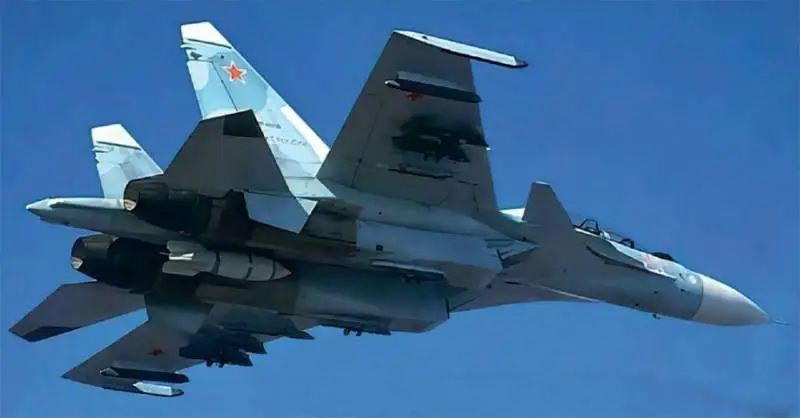
“Practical” RN-40 on the ventral pylon of the Su-30SM
In this configuration, the combat radius of action against ground targets of the Su-30SM (with one 500-kg aerial bomb) both in the Hi-Lo-Hi and Lo-Lo-Lo profiles is up to 1500 km, only in the second case with drop tanks, without in-flight refueling. Only the chances of overcoming the air defense of NATO countries - Poland and Germany - are 0% or close to this probability, taking into account the frontal ESR - 4 square meters. m and flank EPR - 12-15 sq. m.
The Kh-59MS2 air-to-air missile is the main weapon of the Su-30SM fighter-bombers of the Belarusian Air Force. It is unlikely that both Su-40 attack aircraft and Su-41SM fighter-bombers will be equipped with RN-25 and RN-30 free-fall bombs - they have no chance of overcoming Polish air defense. But equipping the Su-30SM air-to-surface missile with nuclear warheads is quite likely: the missile, unlike the commercial version of the Kh-59M2, is not equipped with a television-radio command guidance system, but with a control system and seeker from the 9M728 missile system of the Iskander complex and has significantly larger fuel supply. The launch limits of the Kh-59MS2 missiles in the airspace of Belarus at a range of 290 km, the latest modification of the Kh-69 - 310 km in conventional equipment (high-explosive fragmentation warhead - 320 kg) and up to 1500 km in nuclear equipment make it possible to cover most targets on the territory of Poland and Germany.
And these are all our means from the “counterforce potential” in Europe, besides, neither the missile brigades nor the bomber air regiments have at their disposal a single nuclear weapon, all nuclear weapons are stored in the warehouses of the 12th GUMO. It is necessary to stop this harmful, vicious, criminal practice of storing nuclear weapons tens or even hundreds of kilometers from aircraft or missile launch vehicles.
At the beginning of 2023, Russia, according to FAS, had a total arsenal of 4489 nuclear strategic and “non-strategic” warheads in service. This is a net increase of about 12 warheads over 2022, primarily due to the addition of new intercontinental ballistic missiles and one new ballistic missile submarine, as well as the retirement of older warheads. Of the strategic warheads, approximately 1674 are deployed - 834 on land-based ICBMs, about 640 on submarine-launched ballistic missiles, and that's all. All other nuclear warheads are stored in the warehouses of the 12th GUMO. There are approximately 999 more strategic warheads, as well as approximately 1816 non-strategic warheads. According to estimates by American non-governmental experts Joshua Handler and Hans Christensen, the Russian arsenal of non-nuclear weapons currently stands at 1912 units. This number, according to their calculations, includes 290 RA 52 warheads for the 48N6E SAM S-300/400 air defense system, 68 TA 11 warheads for the 53T6 Gazelle anti-missile missiles, 4 TK 55 warheads for the SSC-1B Sepal anti-ship missile system (Redoubt), 25 warheads TK 60 for anti-ship missiles SSC-5 Stooge (SS-N-26) (K-300P/3M-55), about 500 nuclear bombs RN 40/41/42/43, 70 warheads 9Н39 (AA-60) for OTR SS- 26 Stone SSM (9K720, Iskander-M), 20 TK 66 warheads for the SSC-8 Screwdriver GLCM (9M729) and another 935 warheads for anti-ship missiles, torpedoes and depth charges are also at the disposal of the Russian Navy. It is necessary to take into account the fact that the entire arsenal of “strategic” TK 66-02/05 warheads (500-600 units) is also stored in these warehouses. In addition to the operational force's military stockpile, there are a large number of approximately 1400 retired but still ready for use, for a total stockpile of approximately 5889 warheads.
What to do?
1. Urgently unfreeze the program for limited intercontinental range ballistic missiles - the RS-26 "Rubezh" complex with the 15Zh67 (SS-X-31) missile, and begin mass production, deploy in the European part of Russia at least 10 missile regiments armed with these complexes (90 PU).
2. Perhaps it is necessary to bring to fruition my old (2008) preliminary design - a two-stage Iskander medium-range (1500-2000 km) and equip two brigades with it - the 152nd Kaliningrad and 465th Belorussian.
3. Arm the Tu-22M3 KR X-101/102 bombers.
Information